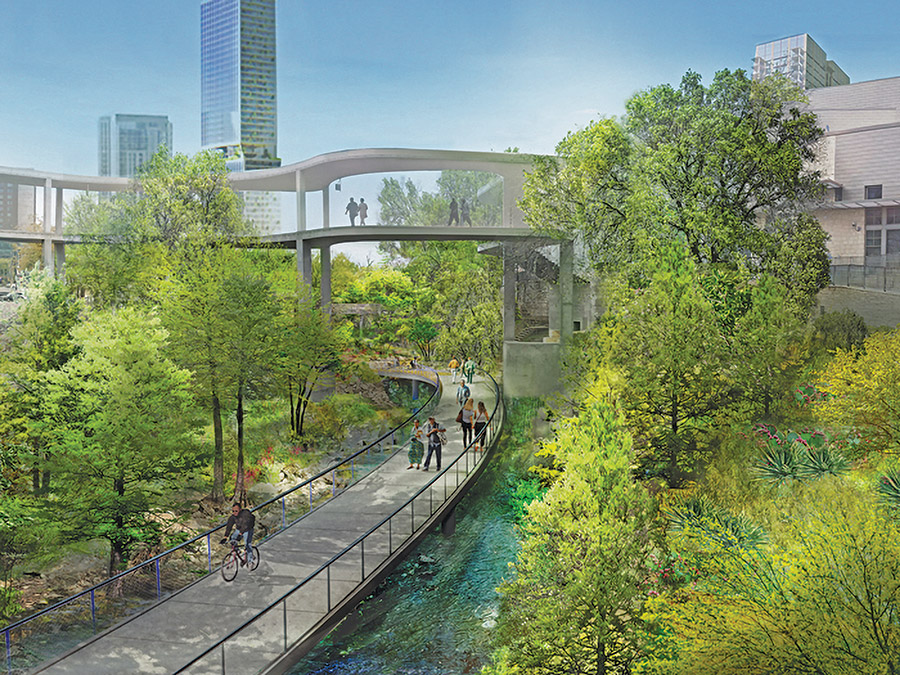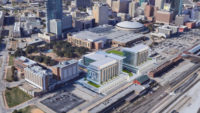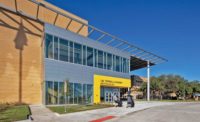Turner Team Wins Texas A&M Fort Worth Campus Contract
Texas A&M University System is expanding into Fort Worth with a three-building research campus. Construction of the first building is set to begin this summer. The university recently announced it had selected a triple venture team of Turner Construction Co., Dallas-based CARCON Industries and Fort Worth-based Source Building Group Inc. for the $85-million Law and Education Building. The team for the 225,000-sq-ft building also includes Dallas-based Dikita Enterprises, architect-of-record Stantec and design partner Pelli Clarke & Partners.
The contractor “will maximize opportunities on this project for historically underutilized businesses and local Fort Worth trade contractors.”
—Andy Tandon, Turner Construction Co.
Andy Tandon, vice president and general manager at Turner, said in a statement that the construction team would “maximize opportunities on this project for historically underutilized businesses and local Fort Worth trade contractors.” Turner has a page on its website with information for potential subcontractors. Construction on the first building is expected to complete in 2025.
Texas A&M University System, which includes 11 universities and eight state agencies, also is planning to build the Research and Innovation Building and the Gateway conference center and office building at the Fort Worth campus. The buildings would support the law school as well as business, health science, nursing and research programs. They also would include office space for rent to outside businesses.
The university system is funding construction of the Law and Education Building. The other two buildings are set to be financed by a partnership of the university system and the city. The system’s board of regents approved $85 million for the second Fort Worth campus building, and construction is tentatively planned to begin next year.
By James Leggate
ExxonMobil Plans to Build Low-Carbon Hydrogen Plant
ExxonMobil announced Jan. 31 that it has awarded a contract for front-end engineering and design (FEED) to Technip Energies for its planned development of what it touts as the world’s largest low-carbon hydrogen production facility. The company stated that it expects to make a final investment decision for the project by 2024, subject to stakeholder support, regulatory permitting and market conditions.
ExxonMobile expects its Baytown low-carbon hydrogen, ammonia and carbon-capture facility will produce 1 billion cu ft of low-carbon hydrogen per day, making it the largest low-carbon hydrogen project in the world at planned startup in 2027-2028.
According to the company, it expects to capture and permanently store more than 98% of the associated CO2 produced at the site, around 7 million metric tons per year.
“This project allows us to offer significant volumes of low-carbon hydrogen and ammonia to third-party customers in support of their decarbonization efforts,” said Dan Ammann, president of ExxonMobil Low Carbon Solutions. “In addition, the project is expected to enable up to a 30% reduction in Scope 1 and 2 emissions from our Baytown integrated complex by switching from natural gas as a fuel source to low-carbon hydrogen.”
Jay-Reese Wins Phase 2 ‘Confluence’ Contract for Austin Greenway Project

This 13-acre section of the park along Waller Creek would be the park’s most ecologically diverse area.
Rendering courtesy of Waterloo Greenway Conservancy
Local officials in Austin, Texas, recently approved a contract for construction of the $75-million second phase of the city’s Waterloo Greenway park project to Dripping Springs, Texas-based Jay-Reese Contractors Inc.
The Waterloo Greenway Conservancy estimates the entire project cost at $265 million. When completed, the Waterloo Greenway would be a 1.5-mile, 35-acre park running along Waller Creek between 15th Street and Lady Bird Lake in downtown Austin.
Michael Van Valkenburgh Associates Inc. and Thomas Phifer and Partners designed the project.
Jay-Reese has worked on other Austin projects including the Capital Metro Downtown Station, Pfluger Bridge and Lady Bird Lake boardwalk trail. Work is scheduled to begin this year, and the local government corporation is targeting completion in 2025 or 2026.
The Waller Creek Local Government Corp. has dubbed the second phase “The Confluence.” It would be the southernmost section of the park, where the creek meets the lake. Work on this phase is set to include reconstruction and stabilization of the creek channel, plus construction of bridges and trails, installation of inline stormwater treatment devices, construction of a biofiltration pond and wildlife habitat areas plus installation of 200,000 mature plants and nearly 1,550 trees.
In addition to creating a park, the project is designed to improve water quality and the creek’s health, Rodney Gonzales, president of the Waller Creek Local Government Corp., said in a statement, adding that the “Confluence will deliver upon the vision for a connected park system and creek restoration.”
The corporation was created to lead implementation of the project as part of a public-private partnership between the city of Austin and the Waterloo Greenway Conservancy.
Jesús Aguirre, CEO of the conservancy, said in a statement that the phase “is centered around nature and helping connect our community to many amazing historic and cultural downtown destinations.”
By James Leggate
USACE OKs Mitigation Approach for West Shore Lake Ponchartrain Project
On Jan. 23, the Louisiana Coastal Protection and Restoration Authority (CPRA) announced it had received confirmation that the U.S. Army Corps of Engineers New Orleans District selected the River Reintroduction into Maurepas Swamp (MSP) as a mitigation feature for the West Shore Lake Pontchartrain Project (WSLP).
“Implementing these projects together will not only breathe new life into a threatened ecosystem, but it will also provide greater protection against hurricanes and storm surge to over 60,000 Louisianans,” said Gov. John Bel Edwards.
The MSP is a 2,000-cu-ft-per-second freshwater diversion located on the East Bank of the Mississippi River. According to the CPRA, the project will reconnect the Mississippi River to the Maurepas Swamp and revitalize an estimated 45,000 acres with freshwater, sediment and nutrients. The swamp has been cut off from the river for more than 80 years and is one of the largest and last remaining coastal freshwater swamps in Louisiana, says CPRA.
The Corps had previously determined that the MSP will satisfy mitigation requirements for unavoidable wetland impacts caused by the construction of the WSLP.





Post a comment to this article
Report Abusive Comment